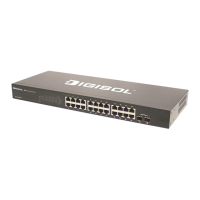C
HAPTER
9
| IGMP Snooping
IGMP Snooping Setting
– 67 –
IGMP SNOOPING SETTING
You can configure the switch to forward multicast traffic intelligently. Based
on the IGMP query and report messages, the switch forwards traffic only to
the ports that request multicast traffic. This prevents the switch from
broadcasting the traffic to all ports and possibly disrupting network
performance.
If multicast routing is not supported on other switches in your network, you
can use IGMP Snooping and IGMP Query to monitor IGMP service requests
passing between multicast clients and servers, and dynamically configure
the switch ports which need to forward multicast traffic.
Multicast routers use information from IGMP snooping and query reports,
along with a multicast routing protocol such as DVMRP or PIM, to support
IP multicasting across the Internet.
IGMP GLOBAL
SETTING
The following parameters are displayed for the Global Setting section of the
IGMP Snooping Setting page:
◆ IGMP Snooping - When enabled, the switch will monitor network
traffic to determine which hosts want to receive multicast traffic.
(Default: Disabled)
This switch can passively snoop on IGMP Query and Report packets
transferred between IP multicast routers/switches and IP multicast host
groups to identify the IP multicast group members. The switch monitors
the IGMP packets passing through it, picks out the group registration
information, and configures the multicast filters accordingly.
◆ IGMP Fast-Leave - Immediately deletes a member port of a multicast
service if a leave packet is received on that port. Fast Leave can
improve bandwidth usage for a network which frequently experiences
many IGMP host add and leave requests. (Default: Disabled)
◆ Unknown Multicast — When the table used to store multicast entries
for IGMP snooping is filled, no new entries are learned. If no router port
is configured in the attached VLAN, any subsequent multicast traffic not
found in the table is either dropped or flooded throughout the VLAN.
(Default: Drop)
◆ Query Interval — Sets the frequency at which the switch sends IGMP
host-query messages. (Range: 60-600 seconds, Default: 125)
◆ Response Time — Sets the time between receiving an IGMP Report
for an IP multicast address on a port before the switch sends an IGMP
Query out of that port and removes the entry from its list. (Range: 10-
25 seconds, Default: 10)

